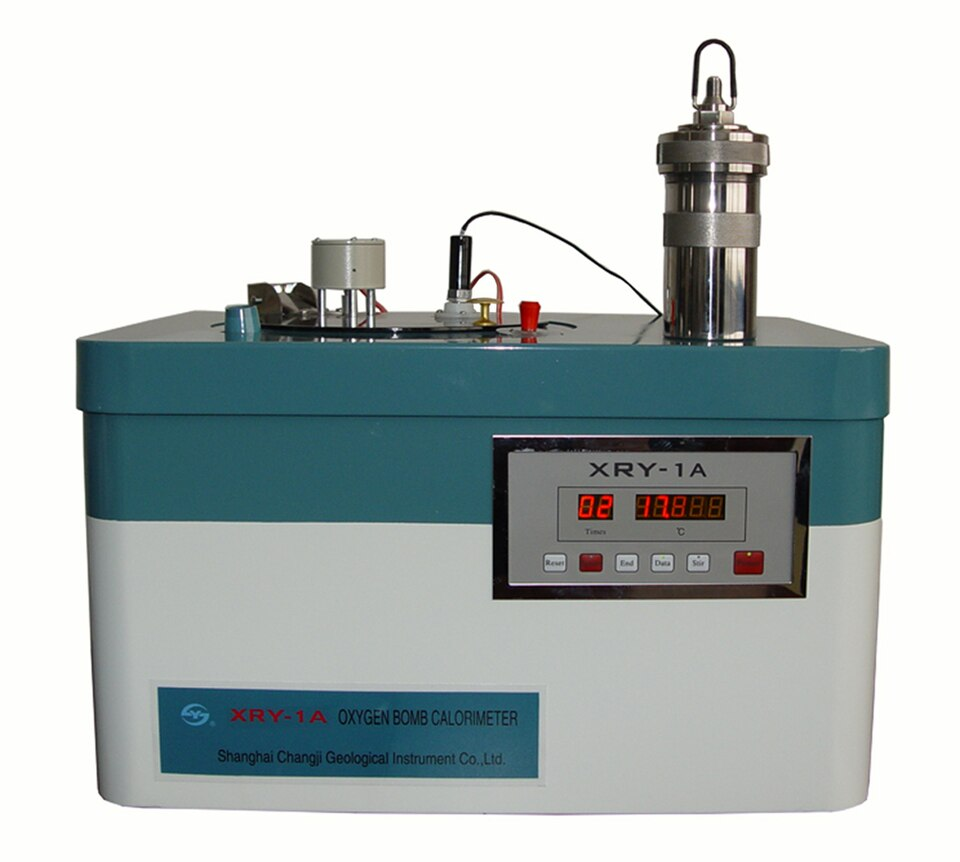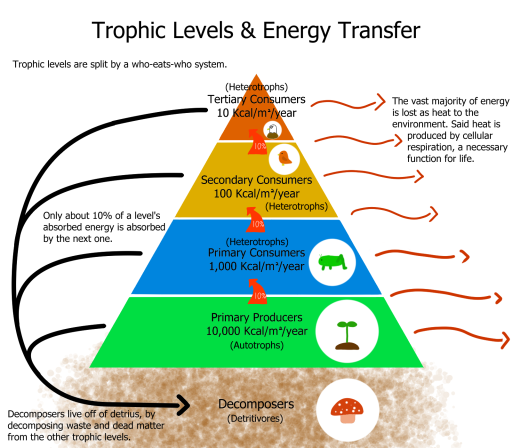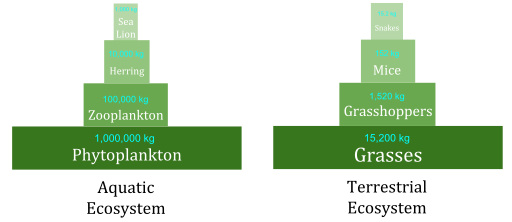OCR Specification focus:
‘Explain how biomass transfers between trophic levels are measured, calculate transfer efficiency, and describe how humans can manipulate transfers.’
Energy transfer within ecosystems underpins all biological interactions. Understanding how biomass moves through trophic levels, and how efficiently this occurs, is essential for evaluating ecosystem productivity and human resource management.
Measuring Biomass Transfer
Biomass and Energy in Ecosystems
Biomass represents the total mass of living material within a specific area or population, usually measured as dry mass per unit area (g m⁻²). It indicates the amount of energy stored in organisms and is used to quantify productivity within ecosystems.
Biomass: The total dry mass of organic material in organisms within a given area or ecosystem.
Biomass provides a snapshot of how much energy is available at a particular trophic level, forming the basis for constructing pyramids of biomass and calculating productivity.
Measuring Biomass
To measure biomass accurately, samples of organisms are collected, dried, and weighed. The drying process removes water content to ensure consistent energy comparisons.
Step 1: Collect representative samples of organisms from each trophic level.
Step 2: Dry samples to constant mass in an oven at around 80°C to remove moisture.
Step 3: Weigh dried samples to obtain dry mass.
Step 4: Multiply the average dry mass by the estimated population size to obtain total biomass per area.
Alternatively, calorimetry can be used to measure the energy content of biomass directly by burning samples in a bomb calorimeter to determine energy released (kJ g⁻¹).

Photograph of an oxygen bomb calorimeter used to determine the energy content of biological material. Seeing the instrument bridges the method described in the notes with real laboratory practice. This image includes extra model-specific detail not required by OCR, but the core apparatus view is directly relevant. Source.
Productivity
Biomass is dynamic, changing as organisms grow, reproduce, and die. Productivity measures the rate of biomass accumulation.
Productivity: The rate at which energy is stored as biomass in plants or consumers over time, expressed in kJ m⁻² year⁻¹.
There are two main productivity measures:
Gross primary productivity (GPP): Total energy fixed by photosynthesis in producers.
Net primary productivity (NPP): Energy remaining after plant respiration (R), available to consumers.
EQUATION
—-----------------------------------------------------------------
NPP = GPP − R
NPP = Net Primary Productivity (kJ m⁻² year⁻¹)
GPP = Gross Primary Productivity (kJ m⁻² year⁻¹)
R = Energy lost in plant respiration (kJ m⁻² year⁻¹)
—-----------------------------------------------------------------
NPP is the key indicator of energy available to the next trophic level and ultimately determines ecosystem productivity.
Efficiency of Biomass Transfer
Energy Transfer Between Trophic Levels
Energy is transferred through feeding relationships, forming food chains and food webs. However, only a small fraction of energy from one trophic level is passed to the next. Typically, 5–20% of energy is transferred between levels.

A pyramid-style diagram of energy transfer between trophic levels with arrows indicating energy passed on and energy lost (e.g., as heat). It visually supports the idea that only a small fraction of energy is available to the next level, underpinning low trophic transfer efficiency. The diagram includes extra general labels on heat loss that go slightly beyond the OCR wording but remain fully syllabus-appropriate. Source.
EQUATION
—-----------------------------------------------------------------
Efficiency (%) = (Energy or biomass transferred ÷ Energy or biomass available at previous level) × 100
—-----------------------------------------------------------------
Energy losses occur due to:
Respiration: Energy used for metabolic processes and lost as heat.
Excretion and egestion: Undigested material and waste products remove energy from the system.
Maintenance: Energy used for movement and thermoregulation.
Incomplete consumption: Not all parts of an organism are eaten (e.g. bones, cellulose).
Trophic Level Structure
Because of inefficiencies at each transfer, higher trophic levels contain less energy and fewer individuals. This results in pyramids of biomass that narrow sharply towards the top, limiting the length of food chains and the size of top predators.

A biomass pyramid illustrating how producers contain the greatest dry mass, with progressively less biomass at higher trophic levels. This reflects cumulative energy losses between levels and explains why food chains are typically short. Labels match the terminology used in OCR A-Level Biology. Source.
Factors Affecting Efficiency
Efficiency depends on the type of organism and environmental conditions:
Endotherms have lower efficiency than ectotherms due to heat loss in thermoregulation.
Carnivores generally transfer energy more efficiently than herbivores, as animal tissue is easier to digest than plant matter.
Cold or harsh environments increase energy losses through heat production and survival mechanisms.
Human Manipulation of Biomass Transfer
Enhancing Primary Productivity
Humans can increase primary productivity (plant biomass formation) to improve crop yields:
Fertiliser application: Supplies nitrates, phosphates, and other minerals to support plant growth.
Irrigation systems: Ensure water availability to maximise photosynthesis.
Pest and weed control: Reduces competition and damage from herbivores.
Selective breeding and genetic modification: Produces crops with higher yields or photosynthetic efficiency.
Optimised light conditions: Use of greenhouses extends photosynthetic time and improves energy capture.
These techniques increase the gross and net primary productivity of agricultural ecosystems, allowing humans to harvest more biomass for food and industry.
Improving Secondary Productivity
Humans also manipulate secondary productivity (energy transfer through consumers) in animal farming:
Restricting movement: Reduces energy lost through activity, improving growth efficiency.
Providing high-protein, balanced diets: Enhances assimilation and growth rates.
Maintaining optimum environmental conditions: Minimises energy expenditure on thermoregulation.
Selective breeding: Produces livestock with favourable growth and feed conversion traits.
Use of growth hormones or antibiotics (regulated in some regions): Improves feed efficiency and reduces disease losses.
By reducing energy losses and improving conversion efficiency, humans increase the proportion of biomass transferred into usable food products.
Sustainability and Ethical Considerations
While manipulation of biomass transfer enhances productivity, it raises ethical and environmental concerns:
Intensive farming can cause animal welfare issues, pollution, and habitat loss.
Fertiliser runoff leads to eutrophication in aquatic ecosystems.
Overuse of antibiotics in livestock contributes to antimicrobial resistance.
Modern sustainable practices aim to balance productivity with environmental conservation and ethical standards, ensuring efficient use of biomass without degrading ecosystems.
Through understanding and managing biomass transfer and efficiency, humans can optimise food production while maintaining ecological balance and sustainability across natural and managed ecosystems.
FAQ
Dry mass gives a more accurate measure of energy content because it removes variation caused by water content, which fluctuates between organisms and tissues.
Fresh mass is quicker and non-destructive but unreliable since water content can vary depending on the time of day, hydration level, or environmental conditions.
In ecological studies, dry mass is preferred for constructing pyramids of biomass and calculating productivity, even though it requires killing the sample organisms.
Aquatic organisms such as fish and zooplankton are often ectothermic, meaning they lose less energy as heat during respiration.
Additionally, buoyancy in water reduces the need for supporting structures like bones or cellulose, so a higher proportion of body mass is digestible.
As a result, energy transfer between trophic levels in aquatic food chains tends to be more efficient than in land-based ecosystems.
Decomposers, such as bacteria and fungi, recycle nutrients by breaking down dead organic matter and waste products.
Although they do not directly contribute to trophic energy transfer, their activity maintains soil fertility and the availability of mineral ions, supporting primary productivity.
This, in turn, increases the total biomass entering the food chain, indirectly improving overall energy flow through the ecosystem.
Biomass transfer efficiency can fluctuate due to:
Temperature: Higher temperatures increase metabolic rates, raising energy losses via respiration.
Food availability: Scarce food reduces consumption and assimilation efficiency.
Reproductive cycles: Energy diverted to reproduction lowers growth efficiency.
Plant productivity: Seasonal light and temperature changes influence photosynthesis and primary productivity.
Together, these factors mean efficiency may be higher in summer and lower in winter in temperate ecosystems.
While both show energy relationships between trophic levels, they measure different things.
A biomass pyramid represents the total dry mass of living organisms, whereas an energy pyramid represents the energy flow over time.
In certain ecosystems, such as oceans, a small standing biomass of phytoplankton supports a much larger biomass of consumers due to high turnover rates — creating an inverted biomass pyramid, but energy pyramids are always upright because energy flow is unidirectional and decreases with each level.
Practice Questions
Question 1 (2 marks)
Explain why only a small percentage of energy is transferred from one trophic level to the next in a food chain.
Mark scheme:
1 mark for each correct point:
Energy is lost through respiration as heat.
Energy is also lost through excretion, egestion, or because parts of the organism are not eaten.
Question 2 (5 marks)
Describe how humans can manipulate both primary and secondary productivity to increase the efficiency of biomass transfer in agricultural systems.
Mark scheme:
Award 1 mark for each valid point up to 5 marks:
Primary productivity: Fertilisers added to soil to supply mineral ions (e.g. nitrates, phosphates) and enhance plant growth.
Primary productivity: Use of irrigation and greenhouses to optimise water and light availability for photosynthesis.
Primary productivity: Control of pests and weeds to reduce competition and damage to crops.
Secondary productivity: Restrict movement of livestock to reduce energy loss through muscle activity.
Secondary productivity: Provide a high-protein, balanced diet or selective breeding to improve growth rate and feed conversion efficiency.
Additional valid point (for extended discussion or alternative approach): Maintain optimum environmental conditions (e.g. temperature) to reduce energy expenditure on thermoregulation.

